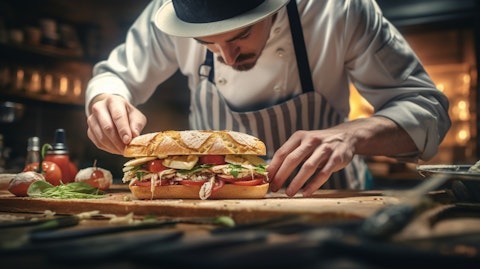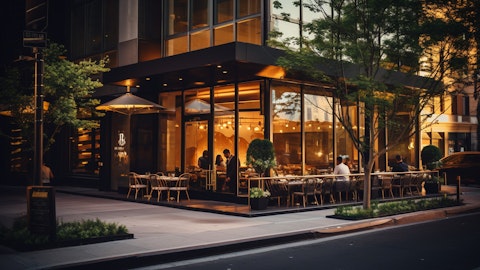Potbelly Corporation (NASDAQ:PBPB) Q2 2025 Earnings Call Transcript August 6, 2025
Potbelly Corporation beats earnings expectations. Reported EPS is $0.09, expectations were $0.08.
Operator: Good afternoon, everyone, and welcome to Potbelly Corporation’s Second Quarter 2025 Earnings Conference Call. Today’s call is being recorded. [Operator Instructions] On today’s call, we have: Bob Wright, President and Chief Executive Officer; Steve Cirulis, Senior Vice President and Chief Financial Officer; and Adiya Dixon, Senior Vice President, Chief Legal Officer and Secretary of Potbelly Corporation. At this time, I’ll turn the call over to Adiya Dixon. Please go ahead.
Adiya Dixon: Good afternoon, everyone, and welcome to our Second Quarter 2025 Earnings Call. By now, everyone should have access to our earnings release and accompanying investor presentation. If not, they can be found in the Investors section of our website. Before we begin our formal remarks, I need to remind everyone that certain comments made on this call will contain forward-looking statements regarding future events or the future financial performance of the company. Any such statements, including our outlook for 2025 or any other future periods, should be considered forward-looking statements within the meaning of the Private Securities Litigation Reform Act of 1995. These forward-looking statements are not guarantees of future performance nor should they be relied upon as representing management’s views as of any subsequent date.
Forward-looking statements involve significant risks and uncertainties, and events or results could differ materially from those presented due to a number of risks and uncertainties. Additional detailed information concerning these risks regarding our business and the factors that could cause actual results to differ materially from the forward-looking statements and other information that will be given today can be found under the Risk Factors heading in our filings with the Securities and Exchange Commission, which are available in the Investors tab of our website and at sec.gov. During the call, there will also be a discussion of some items that do not conform to U.S. Generally Accepted Accounting Principles or GAAP. Reconciliations of these non-GAAP measures to the most directly comparable GAAP measures are included in the appendix to the press release and investor presentation issued this afternoon, both of which are available in the Investors tab on our website.
And now I’ll turn the call over to Potbelly’s President and CEO, Bob Wright.
Robert D. Wright: Thank you, Adiya. Good afternoon, and thank you for joining our call today. Our second quarter results continue to showcase the strength of the Potbelly brand as our growth engine further accelerates. At a high level, our top line sales momentum continued as we grew same-store sales by 3.2%, including positive traffic. And our shop expansion plans remain on track with 8 successful shop openings in the quarter, ahead of our Q2 expectations. Our team’s disciplined approach to managing both shop level and corporate costs also led to year-over-year shop-level margin expansion to 16.7% and helped us deliver an adjusted EBITDA of $9.6 million, reaching the high end of our guidance range. These strong results truly reflect the growth engine we’ve been building for the past 5 years, leveraging our 5-pillar operating strategy across menu innovation, value, operations, digital and shop growth.
However, at the heart of our continued success is our team’s unparalleled dedication and hard work. I would like to thank every member of the Potbelly family from our frontline staff to our support center employees as well as our franchisees and their teams whose commitment to excellence makes these achievements possible. As we look forward to the second half of the year, our focus will remain on actions that continue to support accelerated growth, both now and into the future. This includes driving comp sales growth through menu innovation and investments in our consumer- facing digital assets as well as data and analytics; growing and modernizing our shop footprint through accelerated unit openings; franchisee growth; market penetration; and remodels of our company-owned units; and lastly, exercising prudent cost controls to achieve balanced growth while also pushing incremental flow-through to our corporate earnings.
Let me walk through some of these actions, starting with innovation. The menu innovation that we’ve introduced over the past year continued to be a driver of our top line performance in the second quarter. As we previously mentioned, we launched an exciting addition to our iconic core menu in mid-April with the all-new Prime Rib Steak sandwich, our first-ever steak sandwich added to the permanent menu. Importantly, customer reception continues to be tremendously positive. Our consumer insights and customer feedback work we did last year helped us understand where we could focus our core menu efforts, and we learned about the menu enhancements and additions that would be most appealing. Recall, the introduction of our Prime Rib Steak sandwich was on the heels of our new slow- cooked pulled pork sandwiches introduced at the end of 2024.
In addition, the launch of Tractor Beverages last year underscored our commitment to innovation across the menu, not just in our legendary sandwiches. Following the end of the quarter, in early July, we continue to elevate the Potbelly menu through the introduction of Potbelly branded Hot Pepper potato chips as part of our partnership with Zapps. These new chips feature the flavor of Potbelly’s signature Hot Peppers and are available exclusively in Potbelly shops nationwide. We’ve also upgraded our salad dressings in partnership with Marzetti to enhance quality and flavor on our salad line. As we look ahead, we carry on testing additional areas of menu innovation through our stage-gate development process, and we look forward to sharing information about the new menu innovation efforts that are currently in test in future calls.
Importantly, our approach to menu innovations remain integral to our 3-part value delivery. The intrinsic value of our core menu is all the better with these exciting new menu items, quality upgrades and flavor enhancements. We also maintain support for everyday value layers with our Pick Your Pair options, $7.99 Skinny value combos and meal deals. And we continue to use our digital channels as our primary method to drive promotional value, especially with our most loyal customers. Again, a balanced use of these 3 layers of value helps us meet customers’ needs in all the ways they use Potbelly while simultaneously driving profitable traffic growth. Moving to digital. Our performance during the quarter remained strong and a long-term driver of our top line momentum.
The seamless integration of our digital advertising, consumer-facing digital assets and Potbelly Perks Loyalty Program, combined with our menu innovations work cohesively to provide Potbelly with multiple sales layers to drive long-term sustainable growth. During the quarter, our digital business represented over 41% of our total shop sales, an increase of approximately 140 basis points versus last year. Building on the strong digital platform, I’m excited to share that in late-June, we launched our new website and mobile app, rebuilding our digital platform from the ground up to deliver meaningful improvements to the customer experience. These enhancements, which were developed based on extensive user insights and customer feedback, represent a key milestone in our ongoing digital transformation strategy.
Through these updates, we made ordering faster and easier than ever. We’ve introduced one-click ordering from the home screen, allowing our fans to instantly reorder their favorites, redeem rewards and explore new menu items with ease. Our refreshed menu layout now showcases more items while incorporating a quick add feature that significantly speeds up the checkout process. We’ve also streamlined navigation with infinite scroll functionality that encourages digital exploration and makes browsing our full menu more intuitive than ever before. We’ve simplified the personalization process with visual cues that guide guests through their choices and a consolidated interface that puts all options on a single page. The checkout experience has been enhanced with path- friendly tools that make it effortless to update, repeat and remove items.

Finally, we’ve made significant changes to allow our Perks loyalty members to effortlessly convert their coins for value-added menu items wherever they are in the experience with simple and intuitive visualizations. As we’ve mentioned, we’re making incremental investments in both consumer-facing digital assets and data and analytics capabilities that we believe will not only make us more competitive, but also more efficient and effective in our digital marketing efforts. While I’m very pleased with what we’ve accomplished with these recent updates, this represents just another step in our digital journey. We have additional enhancements in our development pipeline that will further personalize and streamline the customer experience, and we look forward to sharing more details on these exciting developments in future calls.
Now let me give you an update on our Franchise Growth Acceleration Initiative. Our team once again made meaningful progress across all phases of our unit growth funnel. Starting with unit openings, we are pleased to have opened 8 new shops across our system during the second quarter, above our original expectation of 6 new shops. As we look ahead, we expect to open at least another 8 new shops during the third quarter. More importantly, our future opening plans remain on track, and we believe we continue to have a clear line of sight to open at least 38 new shops in 2025, with all the remaining locations currently under development and driving our confidence in our development expectations for the third and fourth quarter. As a franchise-focused company, we continue to expand through franchise partners who share our passion for the brand.
And thanks to the great work of our franchise team in converting high-quality franchise candidates to franchisees through deal signings, we added 54 new franchise shop commitments during the second quarter, our strongest quarter ever. This brings our total open and committed shop count to 816 shops, surpassing 40% of our long-term potential for at least 2,000 shops. The combination of new shop openings, emerging franchisees and new development agreements and expanded commitments from existing partners continue to reinforce our confidence in accelerated franchise growth for 2025 and beyond. In addition, our remodel tests remain on track with 5 remodels completed through Q2 and several more nearly completed to-date across all 3 tiers. With our various combinations of updated signage, exterior enhancements, interior updates and furniture upgrades, I couldn’t be more pleased with how we’re able to update the overall Potbelly image to our customers’ benefit while still maintaining that special Potbelly environment that remains a competitive advantage for us.
While still too early to share details on traffic lifts and ROI, we are very pleased with the early test results and look forward to sharing more of those details in future quarters. In summary, we are very proud of what we accomplished thus far and excited for what the future holds for Potbelly. We’ve accomplished so much over the past 5 years, but we know that Potbelly is just getting started and believe we are well positioned to capitalize on the immense opportunity ahead of us. With that, I’ll now turn the call over to Steve to detail our financial performance for the second quarter.
Steven W. Cirulis: Thank you, Bob, and good afternoon, everyone. System-wide sales for the second quarter of 2025 increased approximately 6.7% year-over-year to $154.2 million, with total revenue increasing approximately 3.4% year-over-year to $123.7 million. Second quarter adjusted EBITDA was $9.6 million or 7.8% of total revenue. This 13% growth year-over-year was driven by improvement in shop- level margin, continued strong performance of our franchise shops and ongoing disciplined management of G&A. Diving in further, company-operated shop revenue increased approximately 2.5% year-over-year to $118.4 million, while franchise revenue improved approximately 27.7% year-over-year to $5.3 million in the second quarter. This performance was primarily driven by an increase in franchise units.
Average weekly sales were approximately $27,040. And as Bob mentioned, company-operated same-store sales were up 3.2% in the quarter, above the high end of our expectations. The same-store sales growth was attributable to a 1.1% increase in transactions and a 2.1% increase in average check. The higher average check included an approximate increase of 2.7% in gross price. Turning to expenses. Food, beverage and packaging costs were 26.3% of shop sales, an 80-basis point improvement versus the prior year period. This was largely driven by slight commodity deflation of 40 basis points in the quarter. Labor expenses remained flat year-over-year at 28% of sales. Occupancy was 10.6% of sales, a 30-basis point improvement versus the prior year period, mostly the result of sales leverage.
Other operating expenses held steady year-over-year at 18.4% of sales. Shop level margins were 16.7%, an increase of 100 basis points versus last year. General and administrative expenses were 8.7% of system-wide sales, an increase of 50 basis points year-over-year, primarily due to payroll costs, including an increased bonus accrual aligned with our year-to-date performance and nonrecurring consulting and legal settlement costs. We reported a net income of $2.5 million for the quarter. Adjusted net income was $2.9 million, a $400,000 increase versus the prior year period. We believe the strength of our balance sheet provides us the flexibility to fund our growth strategic initiatives, participate in our share repurchase program and align with our broader capital allocation strategy.
During the second quarter, we purchased approximately 113,000 shares of our common stock for a total of approximately $1 million. We anticipate repurchases throughout our 3-year program approved in 2024. Finally, let’s turn to guidance. For the full year 2025, we are increasing our guidance in key areas and anticipate the following: same- store sales growth of 2.0% to 3.0%, up from the previous range of 1.5% to 2.5%; unit growth of at least 38 openings; and adjusted EBITDA of approximately $34.0 million to $35.0 million, an increase from the previous range of $33.0 million to $34.0 million. Incorporating our quarter-to-date results for the third quarter of 2025, we anticipate the following: same-store sales growth of 3.25% to 4.25%; unit growth of at least 8 units; and adjusted EBITDA of $9.0 million to $10.0 million.
With that, I’ll turn the call back over to Bob.
Robert D. Wright: Thanks so much, Steve. As we wrap up today’s prepared remarks, I want to end by highlighting an underappreciated driver of our success. It’s our deep commitment to the communities we serve. I’m particularly proud of our Potbelly Summer of Service initiative, where our teams across the country have demonstrated extraordinary commitment to making a difference in their neighborhoods from partnering with major food banks nationwide, helping provide meals to families in need to supporting important causes like Down Syndrome awareness through annual fundraising events like GigiFIT Acceptance Challenge in Chicago. Our impact has been both broad and meaningful, touching lives in communities large and small across the country.
These efforts reflect our core belief that Potbelly is more than just a sandwich shop. We’re a vital part in the neighborhoods we serve. I want to extend my heartfelt gratitude to our dedicated team members and franchisees who have embraced our mission of community service. Your commitment to showing up, giving back and making a difference has truly brought our values to life. Together, we’re building not just a successful business, but a company that makes a lasting impact in the communities that we call home. As we look ahead, we remain committed to growing our business while deepening our community connections one neighborhood at a time. With that, we’re happy to answer any questions. Operator, please open the line for questions.
Q&A Session
Follow Potbelly Corp (NASDAQ:PBPB)
Follow Potbelly Corp (NASDAQ:PBPB)
Receive real-time insider trading and news alerts
Operator: [Operator Instructions] And our first question comes from Todd Brooks from The Benchmark Company.
Todd Morrison Brooks: Congratulations on the continued momentum in the business folks, that’s great. First question I have and just doing the math, it looks like about 364 signed deals in the pipeline on top of units that you have opened now. I think in the past, you’ve talked about an 8-year type of realization that franchisees have to open their commitment within. But I know there’s some kind of incentives in place and some of the bigger franchisees are better versed to open more quickly. How long do you think it takes to realize that pipeline? Because we’re starting to get to meaningful numbers here in that 50-unit range just from the known pipeline right now for franchisee openings going forward?
Robert D. Wright: Yes, it’s a great question, Todd. And it ties to what we’ve been talking about as our long-term algorithm for growth rates in the double digits when it comes to unit count. And you’re right, your 8-year horizon is what we see as the maximum timeline for shop development area agreement with a franchisee. So if you think about one of those large area developers, let’s say, they’ve signed for 16 shops, they’re going to deliver 2 a year. At the same time, if a franchisee signs any less than 8 units to a development agreement, then they get a year per unit. So — we don’t necessarily spread all of those shops over 8-year period of time because if it’s a smaller development agreement, we’re still going to get a unit a year and they get a little bit shorter time.
So yes, as you start to digest all these commitments that have come into the system, and especially, as those multiunit developers find their footing, they work in the real estate market like we’ve talked about many times and they get those approvals in place, they can see multiple openings a year. Both larger and smaller franchisees have a small incentive on the table if they can open ahead of schedule. And it’s mutually beneficial. We call it our 50-50 incentive because they can get a discount on their royalties during the weeks that they weren’t expected to be open. For them, that’s additional money that puts towards their deal. And for us, we still got half of the royalties that we hadn’t baked into our plan. So it’s a win-win for both of us.
Todd Morrison Brooks: That’s great, Bob. And just a quick follow-up, and then I’ll jump back in queue. And I’m not sure how exactly to frame up what we just discussed there, but what it sounds like to me is we have visibility into 50-plus franchise openings next year. But you’ve also talked about an element of accelerated corporate openings to try to densify a few of the key company store markets. I think you’ve talked about 10 to 20 a year. Thoughts on that as we’re looking out to ’26, is that corporate store pipeline shaping up at all? And do you temper that back at all given the momentum that you’re seeing just from a franchisee signing standpoint?
Robert D. Wright: No. Thanks for the chance to clarify that, Todd. I appreciate it. Look, you’re right. While we’re not guiding to our 2026 opening rate, we’ve got really nice visibility into that pipeline. And because we’ve been building the pipeline for this period of time, we — frankly, what we can see more of is a little more front-half loaded than back-half because the back-half is going to fill up as we go through the back-half of this year, right? So that continues to build with our franchisees. We have said that we would build up to 20 company units a year. We’re not making commitments for the number to be that high because we’re looking for the intersection of a few key variables where we would build a company site, densifying a market that we’re already in, markets that have really nice margins for us and lower than nationwide average construction costs, and markets that we don’t already have franchisees growing in.
So — we think that’s an important earnings builder for our brand and for our company, while at the same time, it’s true to our unit growth story without getting in the way of what’s really the biggest part of unit growth is [ for those ] franchise unit developments. So yes, we’ll be guiding to those ’26 numbers soon enough, but we’re very pleased with how those 2 elements are shaping up to make the year look strong.
Operator: And the next question comes from Jeremy Hamblin from Craig-Hallum Capital Group.
Jeremy Scott Hamblin: I’ll add my congratulations on the strong results. I wanted to dive into the same-store sales in a bit more detail and see if you can share a bit more on — you noted positive traffic, which is fantastic in Q2, but I wanted to see from — of that 3.2% growth, what was transaction, what was check? And then how you’re looking at menu pricing and potential mix here as we are in Q3.
Robert D. Wright: Sure. Yes, Jeremy, let’s — Steve and I tag team that. He can give you the pricing and the mix piece, and then we’ll talk a little bit about why we have the confidence in what happened, can continue to happen too.
Steven W. Cirulis: Sure. So Jeremy, the breakdown of the 3.2% same-store sales growth for us at — on the corporate side was 1.1% growth in traffic. That’s a transaction number and then 2.1% average check increase. Our gross price was 2.7%, and that will give you a 0.6% slight drop in mix to create that decomposition for you.
Jeremy Scott Hamblin: Perfect. And just a little bit of color maybe on the cadence throughout the quarter, April, May, June. And obviously, it sounds like Bob is excited to share a bit of why you have confidence on a really strong same-store sales guidance for Q3.
Steven W. Cirulis: As Bob mentioned in his remarks that we accelerated through the quarter in terms of our same-store sales. So business continued to strengthen. And that’s in the face of an Easter shift that didn’t fall our way, and that’s also taking into account the 4th of July component that sometimes creeps in at the bottom of the quarter. But we’re — and [ June 10 ] was another element. So all of those factors still resulted in us continuing to build our same-store sales through the quarter.
Robert D. Wright: Yes, Jeremy, I think the thing that we’re excited about is that we’re seeing growth across multiple channels. We talked again about the 41% digital business. And we’re seeing growth across multiple strategic initiatives. It’s all been part of this plan that we’ve been building. So the menu innovation, those 3 layers of value, the digital efforts that we’ve had in place, the consistent attention to detail with operations and the staffing that we have and the stability and the turnover levels that we have in our shops. And I think as you hear us talk about things like the rollout of the new web and the app in June and the platform that, that allows us to lean even further into some of these areas. You heard my comments mentioning that we have — we still have additional testing related to the menu.
And sometimes it’s as big as a steak sandwich like it has been. And of course, the Marzetti dressings. We think those are very important moves. They may not be as flashy as an add to the sandwich line, but just really continuing to focus aggressively on the core menu itself. That is the base of that value structure that we have. And I think what you’re hearing is that the success in the traffic driving capability is the same thing that we’re drawing our confidence in for the future. And we obviously wouldn’t raise sales guidance if we thought we could see the continuation of the accelerated momentum that we’ve seen this year.
Jeremy Scott Hamblin: Got it. And can you elaborate a little bit on that menu innovation? I mean I know you may not talk about specific things, but can you talk a little bit about the timeline? It sounds like there’s potential for either other launches in the back half of the year or testing of items.
Robert D. Wright: Yes. We have — and you’re right, we don’t want to overpromise here. We always prefer to talk to you all about what we’ve done and why we’re confident about what we’re working on. But we do have additional menu innovation work in test now. It’s a little too early to talk about exactly where that’s going, but we have that in some of our shops in some of our markets. And we certainly have a view to what else is in that stage gate process and that stage gate pipeline and what could come next after that. And it’s a blend of products and product — products that we put on the menu and the ingredients that make those products. So we want to just keep elevating our quality game and giving our customers more reasons to come in.
I think for us, we get asked questions sometimes about specific product items. And I think you’ve seen the pattern is what you should expect to see in the future. It’s adjacencies to the current menu. It’s what our customers and our research has told us they would reward us for if we would invest in those things in the menu. It is what is accepted by the current fast casual and Potbelly consumer. So we — our research was pretty clear for us that we knew steak sandwich was going to hit if we got the right product. And so we spent the time developing that. There are other things like that, that our customers have told us that they would reward us for. And what we’re working on is finding the right solution for that reward.
Jeremy Scott Hamblin: Got it. Last one for me, real quick. I wanted to see if you could make some comments around cost of goods. Tariff noise is kind of still out there and creating a bit of confusion, but wanted to see if you could share visibility that you feel like you have here on food costs in the back half of the year.
Steven W. Cirulis: Sure. Sure. It’s perhaps a nice benefit that we’re not a manufacturing company here in this sense because we don’t really have a lot of exposure to those kinds of items that would fall under, at least as of today, the proposed tariffs. There was some thought earlier that with avocados that we get from Mexico and so forth that we might have some exposure. And we probably do if those things fully come to fruition. But as we look at the year, so far, we benefited from a really favorable commodity year, some deflation, right, in some cases. But as we look to the back half, at least from what we can see, we’ve got food cost inflation here as we’re looking at third quarter, just shy of 2% is our forecast. And then something as we head into the fourth quarter, we have a bit of a step-up for us anyway in a different distributor relationship, and it steps up a little higher than that, but it’s just a little north of 2%.
So it’s fairly benign. And so we’re locked in on our baskets 99% for this quarter and about 85% for the year. So barring any wild changes from the administration, I think our food costs are in a manageable state [ now, ] to say the least.
Operator: The next question comes from Mark Smith from Lake Street Capital.
Mark Eric Smith: I wanted to ask first just about the balance sheet a little bit. The debt is now all gone. Just curious your thoughts around capital deployment, if there’s more interest in buybacks or other places where you see putting capital to work?
Steven W. Cirulis: Sure. Sure. I think we’ve mentioned in the past that we think about our capital strategy in this way. We want to continue to invest in our assets, right? So those are going to be our existing shops. And Bob discussed, he can give a little more color to the remodel program that he mentioned in his opening remarks and those new units that we’re going to continue to build. That’s kind of on the growth side for us. So those things that will drive some additional same-store sales, we believe, and certainly more revenue. And then we want to invest in our technology as well. And there’s a lot of evidence of that showing up already. The new web and app that recently launched is one manifestation of that, but then rebuilding our tech stack and allowing for even greater marketing capabilities and more sophisticated ways to reach our customers is something that we’ll continue to invest in.
Over 40% of our business is digital, that’s something that we’re going to continue to spend our capital on because we believe it’s high return — high-return capital. And we also spend a fair amount of money on maintaining our fleet, right? There’s always routine maintenance that creeps into our capital spend, but that goes back to kind of reinvesting in our assets. And we have, as you know, a share buyback program in place. I mentioned we were in the market last quarter, and we’ll continue to put capital there. But I would say that for us, the first best use of capital is — are those high-return strategic initiatives that push us far beyond our cost of capital and lay the groundwork for continued growth in the future. And what you’re seeing right now is those multiple layers of growth kind of all hitting at the same time, which are pushing our same- store sales and driving some of that traffic.
So that’s a plan and a model and a strategy that’s working for us, and we’ll continue to play it out like that.
Mark Eric Smith: Perfect. And I did want to ask about the remodels a little bit as well as prototypes. What kind of returns or any — how pleased are you as you look at results from remodeled restaurants or even kind of new prototypes? Any updates there would be great.
Robert D. Wright: Yes, happy to. I’ll hit the prototype, first of all, because that really relates to how pleased we are with new shop openings. And suffice it to say, we are very pleased with the performance of our new shop openings, but I’d add to that, that we’re never satisfied. With the build costs and the sales returns that we get and our franchisees are enjoying when they’re building new shops. The areas that we’ve been working on are, as you can imagine, in restaurant development, are there things that we can do to pull costs out of our new shop builds. We do have a prototypical design. We’re very, very happy with that design, but we think that we continue to economize some of the construction costs. In fact, we have a recent build where we tested some of those design adjustments and things that we pulled — we have — we don’t think — we have pulled tens of thousands of dollars out of the construction costs.
And I think we did a marvelous job preserving the Potbelly experience and the Potbelly feel. We’re very quick about incorporating any of those proven enhancements that can bring cost down in the very next iteration because as we talked before, the prototype is a design standard. It isn’t a cookie-cutter one-size-fits-all box that has to be exactly the same. When we’re going into lease spaces, sometimes they’re rectangular, sometimes they’re square. And so because it’s a design standard, we can incorporate these changes, whether it’s materials, construction style there’s some stuff, even the intricacies of how some of the wall framing is being done. We pulled costs out. The customer would never see that and it saves thousands of dollars. So there’s the construction side of things that we think is really important.
Then on the revenue side, again, we’re pleased but not satisfied. There are some things that we’ve started to learn now that we’ve opened several shops this year and continue to open them that we think we can do even better. So even though we’re happy with the opening sales growth because we’re partnering with our franchisees, there are some things we’re learning about how we can kick start catering a little bit faster. Some things we’re learning about how we can train a little more aggressively for those first few days with our dream teams that are in place. And these are all things that were not problems. They’re just once you get rolling, you find there are more and more better ways to do this well. And those are the things, obviously, that franchisees will continue to invest in.
We get very high marks with our franchisees because we’re very open about these enhancements. And when they have feedback, we incorporate it and we make the next opening even better. I think it’s important to note, too, Mark, that we’re opening on time. The process is getting sharper and better, too. This is all infrastructure team, skills and functions that were built. We’ve been building them over the last 5 years. And so I’m really pleased. And it’s broad-based. I mean, gosh, this quarter, we’ve opened shops in 7 different states. So it’s not highly concentrated in that way. Now what’s neat about the prototype work is it lends itself really well to the remodels you asked about. And I know in my prepared remarks, we talk about these 3 levels of remodels, and we have fun here, so we named them after our sandwich sizes; Skinny, Original and Big.
And they — that essentially matches the price banding that it takes to what are we looking at in the various scale of remodel. But it is some combination of signage, exterior work, interior work and you get into furniture and some fixtures, too, if you’re into that big size remodel. We have one of our shops that’s been with us so long. It’s got a single-digit shop number. So top 10 original shops, it’s going to get a big remodel. We won’t state exactly where that is, but it’s going to really, I think, be boosted by a full-blown retouch of the exterior and the interior. And we’ve had some recently of the 5 that I mentioned that we’ve already done that were just signage. And our new logo, our new branding that we rolled out a couple of years ago, it really pops.
And in some cases, we see people from the neighborhood that are glad we “Finally Opened” just by replacing the signage. So really pleased with the remodel so far. We’ve got a lot of testing to do. We need our PPNoC, our Pre-Post Net of Control assessment that Steve holds us very closely accountable for before we can start sharing some of the details. But we’re watching — you heard me mention it, we’re watching lift and return on those remodels because we have experience with other brands to get this right and it can drive top line growth that adds profit to the bottom line that we really like. Not to go on and on, I do want to mention one last thing that kind of crosses both of those, and that’s our PDCX investment. Steve talked about technology and assets.
And this is the in-shop technology, that new POS with the new kitchen display system, and we’ve even added this handheld ordering system that we think has upside to help drive the busiest dayparts and help us handle that big demand during the busiest dayparts. And so when we do — when we open every shop, it gets the new PDCX system. And of course, as we’re doing remodels, we’re going to do that, too. But all of our shops will get the new POS by the end of next year.
Mark Eric Smith: Perfect. If I can squeeze in one more, kind of twofold. I would love to hear if you saw any change in consumer behavior, whether it was cutting out chips or drinks or anything as consumers were a little squeezed here in the quarter. And with that, I would love to hear if you can discuss it at all competitively, if there’s any real differences between the digital customer and counter order customer on check size or upselling them digitally?
Robert D. Wright: Yes. I mean I think when it comes to the consumer, you’ve heard a lot of other brands talk about that low-income consumer. We do watch the spending by income bracket among a number of other variables. And there definitely seems to be some pressure on the low- income consumer that $40,000 and $50,000 and below makes up a pretty small percentage of our traffic. And so we’re able to grow the business in spite of that pressure on the lower end that you’re hearing about from — especially from some other brands. And at the end of the day, we’re watching that people are still employed. They’re still seeing wage inflation that’s outpacing their consumer inflation. And when it comes to lunch, fast casual still sits in a great place.
I mean you can come eat a Potbelly for $8. For $9, get a whole meal. And that’s the threshold that our research tells us that is really important even if someone is watching their dollars in their wallet. And at the same time, if you want to spend a couple of extra dollars on the premium Prime Rib Steak Sandwich and maybe even get it in a big size, we’ve got that for you, too. Clearly, in the digital space, one of the advantages is people spend a little more time cruising the menu, cruising through the menu, maybe adding a cookie, maybe adding an additional drink for their — to put on their shelf or something. And you can see the check growth with that. That can be party size, too, that influences check growth. And the other side of that is that we also have an ever more successful relationship with our Perks loyalty consumer.
And they love the fact that they can use those coins that they earn and turn around and cash those in. So even though they may be adding things to their menu, they can use 300 coins and get a free cookie, too.
Operator: And the next question comes from Matt Curtis from William Blair.
Matthew James Curtis: I’ll add my congratulations on the quarter. On the digital side, guys, have you seen any meaningful difference in sales trends between mobile order and pickup versus delivery? And then following the digital enhancements that you rolled out in late-June, which I guess mostly designed to make ordering faster and easier. Have you seen any meaningful uptick in digital sales in the month of July?
Robert D. Wright: Yes. So Matt, first of all, thanks. Thanks for the comments and the question. When you talk about the last question first, we just rolled this out in June, and we’re certainly not going to talk about the components of that momentum — continuation of momentum in July, but we are really pleased with what we’re seeing in the early data with the web and app, particularly with the behaviors that we had hoped to see reflected in the orders that are related to the enhancements that we particularly designed into it. And we’ll talk more about this in the future, but it’s not just the app and the web, but it’s the tech stack that sits underneath it that gets unlocked because of that code that we think is very exciting for us into the future.
In terms of the movement within the digital space and the traffic movement between inside digital pickup versus digital delivery versus third-party digital delivery, we haven’t seen a significant shift in those behaviors here in this last quarter. It’s kind of similar to the behavior that we have been enjoying in the past. We keep finding ways to make our first-party digital the most attractive place for people to go. And we like where we sit in terms of the overall mix. We’ve said all along, we’re in those third-party channels because that’s where a lot of our customers are. We’re certainly not going to turn our backs on that business. But we’re successful in finding more and more ways to get people pivoted back to the first-party digital channels, whether they’re using it for delivery or pickup.
And in fact, they get smarter and smarter. They often order for pickup and still come in and grab it off the shelf and sit down and dine.
Operator: Ladies and gentlemen, we have reached the end of today’s question-and-answer session. I’d like to turn the call back over to Mr. Bob Wright for closing remarks.
Robert D. Wright: Thank you, operator. We really appreciate everyone being on the call with us today. We’ve reached the end of our call, but I think what you’re hearing from us tonight is that we’re very excited about where Potbelly sits today. The growth story continues, and we certainly look forward to talking to you again soon. Have a great night.
Operator: The conference has now concluded. Thank you for attending today’s presentation. You may now disconnect.
Follow Potbelly Corp (NASDAQ:PBPB)
Follow Potbelly Corp (NASDAQ:PBPB)
Receive real-time insider trading and news alerts





